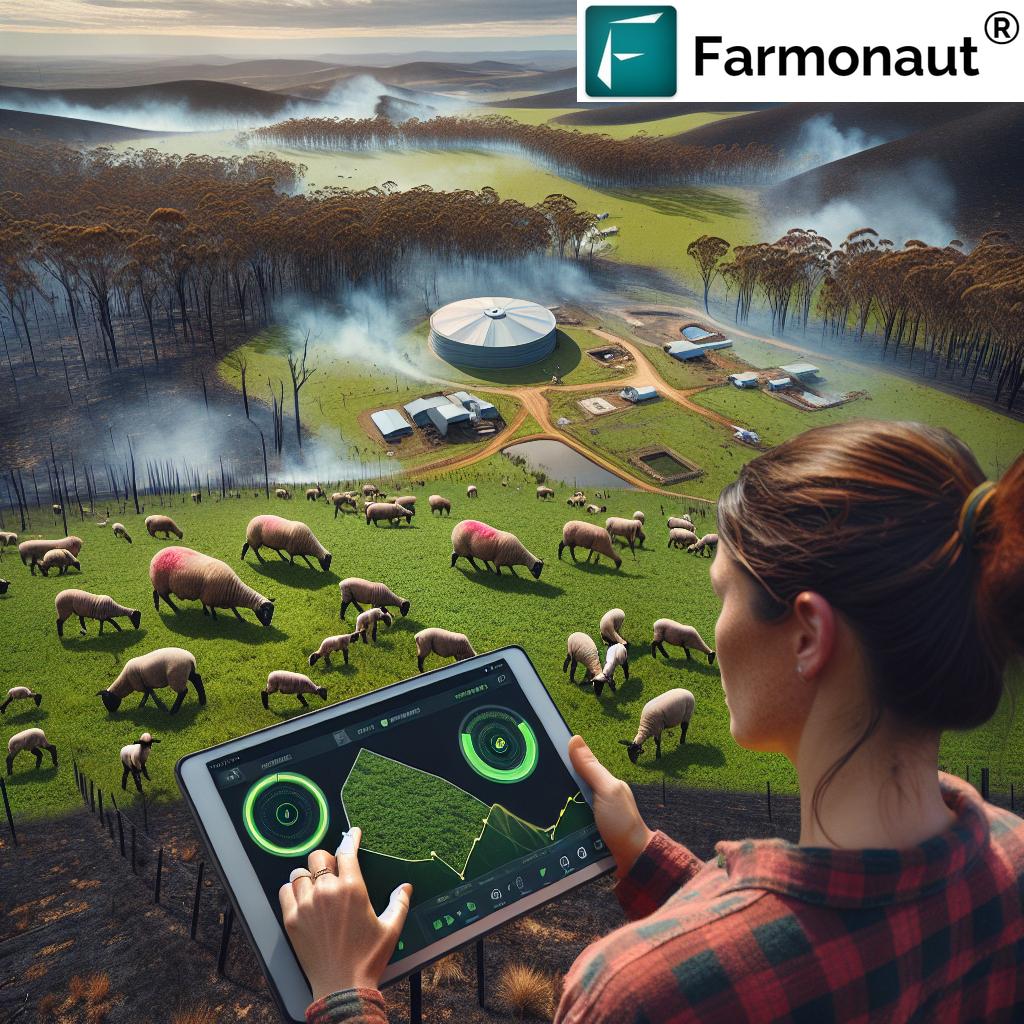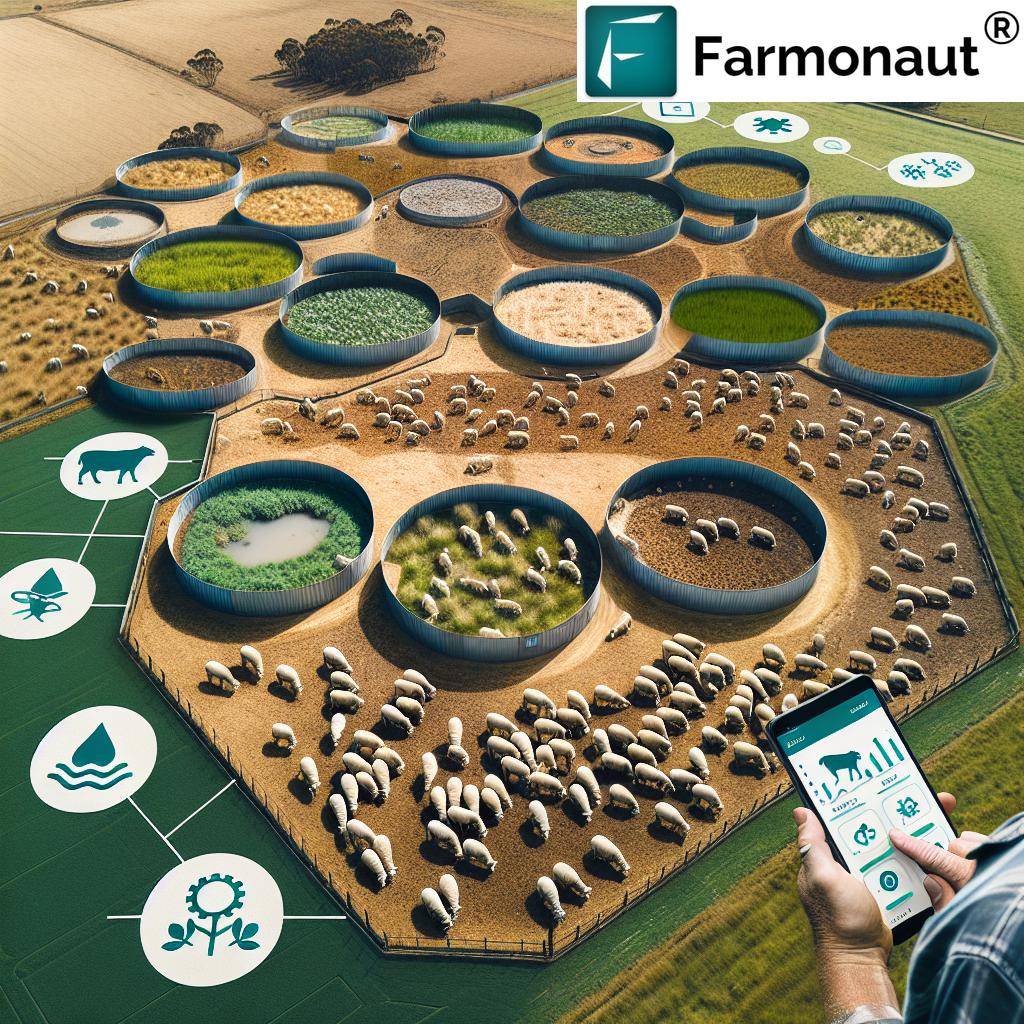Mastering Bushfire Recovery: Essential Strategies for SA Sheep Producers with Farmonaut’s AgriTech Solutions
“Post-bushfire recovery strategies address at least 10 key areas, including grazing, animal health, infrastructure, and pasture management.”
Bushfires can be devastating for South Australian (SA) sheep producers, leaving a trail of destruction that affects every aspect of farm operations. In this comprehensive guide, we’ll explore essential strategies for bushfire recovery for farmers and livestock management after fires, with a focus on how Farmonaut’s innovative AgriTech solutions can aid in the recovery process. From immediate response to long-term planning, we’ll cover all the crucial steps needed to rebuild and thrive in the aftermath of a bushfire.

Immediate Response: The First Steps in Bushfire Recovery
When the flames subside, the journey to recovery begins. Here are the critical first steps SA sheep producers should take:
- Safety First: Ensure the safety of people and animals before re-entering affected areas.
- Damage Assessment: Conduct a thorough assessment of farm infrastructure, livestock, and pastures.
- Emergency Feeding: Implement emergency feeding strategies for surviving livestock.
- Water Supply: Secure clean water sources and check for contamination in dams and catchments.
- Seek Support: Contact local authorities and support services for immediate assistance.
Farmonaut’s satellite-based crop health monitoring can provide an immediate overview of the extent of damage to pastures, helping farmers prioritize their recovery efforts efficiently.
Livestock Health and Welfare: A Priority in Post-Fire Management
Livestock management after fires is crucial for the survival and recovery of your flock. Here’s what you need to focus on:
- Health Checks: Assess all animals for burns, smoke inhalation, and other injuries.
- Vaccination: Update vaccination protocols to prevent disease outbreaks in stressed animals.
- Pest Control: Implement strategies to manage flies, lice, and other pests that may proliferate post-fire.
- Nutrition: Develop a feeding plan that addresses the nutritional needs of different groups (ewes, lambs, weaners, rams).
Farmonaut’s Jeevn AI Advisory System can provide personalized recommendations for livestock care based on real-time data and expert knowledge, helping farmers make informed decisions about animal health and nutrition.
Pasture Recovery and Grazing Management
Implementing effective post-fire grazing strategies is essential for long-term recovery. Consider the following approaches:
- Rest Periods: Allow burnt pastures sufficient time to recover before reintroducing grazing.
- Rotational Grazing: Implement a rotational grazing system to prevent overgrazing of recovering areas.
- Supplementary Feeding: Use containment areas for feeding to reduce pressure on regenerating pastures.
- Weed Management: Be vigilant about weed control in the post-fire environment.
Farmonaut’s satellite imagery can help monitor pasture regrowth, allowing for data-driven decisions on when and where to reintroduce grazing.
Farm Infrastructure: Rebuilding and Improving
Farm infrastructure assessment and rebuilding is a critical component of bushfire recovery. Focus on:
- Fencing: Prioritize boundary fences, then internal fencing for grazing management.
- Water Systems: Repair and upgrade water infrastructure, considering drought-proofing measures.
- Buildings: Assess and repair damaged sheds, yards, and other essential structures.
- Fire-Resistant Design: When rebuilding, incorporate fire-resistant materials and designs.
Farmonaut’s fleet and resource management tools can help optimize the use of machinery and resources during the rebuilding process, ensuring efficient allocation of assets.

Soil Health and Erosion Control
Protecting and improving soil health is crucial for long-term recovery. Implement these strategies:
- Erosion Prevention: Use erosion control measures such as contour banks and cover crops.
- Soil Testing: Conduct comprehensive soil tests to assess nutrient levels and pH.
- Organic Matter: Incorporate organic matter to improve soil structure and water retention.
- Minimized Tillage: Use conservation tillage practices to protect soil structure.
Farmonaut’s satellite-based soil moisture monitoring can help farmers track soil conditions and make informed decisions about soil management practices.
Water Management in Post-Bushfire Landscapes
Effective water management is critical in bushfire-affected areas, especially during drought conditions:
- Water Quality: Regularly test water sources for contamination from ash and debris.
- Storage Capacity: Consider increasing water storage capacity to prepare for future droughts.
- Efficient Irrigation: Implement water-efficient irrigation systems where applicable.
- Catchment Restoration: Restore and protect water catchments to ensure long-term water security.
Farmonaut’s precision agriculture tools can help optimize water usage by providing accurate data on soil moisture levels and crop water requirements.
Sustainable Feeding Strategies for Livestock
Developing sustainable livestock feeding methods is crucial for long-term recovery and resilience:
- Fodder Planning: Develop a long-term fodder production and storage plan.
- Alternative Feeds: Explore drought-resistant feed options and novel feed sources.
- Nutritional Balance: Ensure rations meet the nutritional requirements of different livestock groups.
- Feeding Infrastructure: Invest in efficient feeding systems to minimize waste and labor.
Farmonaut’s AI-driven advisory system can provide tailored recommendations for feed management based on local conditions and livestock needs.
“Effective bushfire recovery plans can improve farm productivity by up to 30% through optimized resource management and sustainable practices.”
Implementing AgriTech Solutions for Disaster Recovery
Agritech solutions for disaster recovery can significantly enhance the efficiency and effectiveness of recovery efforts. Here’s how Farmonaut’s technologies can be leveraged:
- Satellite Monitoring: Use satellite imagery to assess pasture recovery and identify areas needing attention.
- AI-Powered Advisories: Receive personalized recommendations for crop and livestock management based on real-time data.
- Precision Agriculture: Implement precision farming techniques to optimize resource use and improve productivity.
- Data-Driven Decision Making: Utilize comprehensive farm data to make informed decisions about recovery strategies.
By integrating these AgriTech solutions, SA sheep producers can accelerate their recovery process and build more resilient farming systems.
Business Recovery and Financial Management
Recovering from a bushfire requires careful financial planning and management:
- Financial Assessment: Conduct a thorough assessment of your financial position post-fire.
- Insurance Claims: Work closely with insurers to process claims efficiently.
- Government Assistance: Explore and apply for relevant government support programs.
- Diversification: Consider diversifying income streams to build financial resilience.
- Benchmarking: Use industry benchmarks to set realistic recovery goals and track progress.
Farmonaut’s data analytics can provide valuable insights for benchmarking farm performance and identifying areas for improvement.
Risk Management and Future Preparedness
Incorporating lessons learned from the bushfire experience is crucial for future preparedness:
- Fire Prevention: Implement fire prevention measures such as firebreaks and reduced fuel loads.
- Emergency Plans: Develop and regularly update comprehensive emergency response plans.
- Climate Adaptation: Adopt farming practices that are resilient to changing climate conditions.
- Technology Integration: Embrace AgriTech solutions for improved monitoring and early warning systems.
Farmonaut’s real-time monitoring and AI-driven insights can play a crucial role in early detection of potential risks and implementation of preventive measures.
Rebuilding Biodiversity and Ecosystem Health
Restoring the ecological balance is essential for long-term farm health:
- Native Vegetation: Encourage the regrowth of native plant species to support local ecosystems.
- Wildlife Corridors: Establish and maintain wildlife corridors to support fauna recovery.
- Pest Management: Implement integrated pest management strategies to control rabbits, foxes, and wild dogs.
- Soil Biota: Promote soil health to support the recovery of beneficial soil organisms.
Farmonaut’s satellite imagery can help monitor vegetation recovery and identify areas that may require additional support or protection.
Explore Farmonaut’s API for advanced satellite data integration
Community Support and Knowledge Sharing
Recovery is often a community effort. Engage with your local farming community:
- Support Groups: Participate in or establish farmer support groups to share experiences and resources.
- Knowledge Exchange: Attend workshops and seminars on bushfire recovery and resilience building.
- Collaborative Projects: Engage in community-led recovery initiatives and research projects.
- Mental Health: Prioritize mental health and well-being, seeking support when needed.
Farmonaut’s platform can facilitate knowledge sharing by providing a common data framework for comparing recovery strategies and outcomes across farms.
Leveraging Technology for Sustainable Recovery
Embracing technology is key to building a more resilient and sustainable farming system:
- Remote Sensing: Utilize Farmonaut’s satellite imagery for comprehensive farm monitoring.
- Data Analytics: Leverage big data analytics for informed decision-making in recovery planning.
- IoT Devices: Implement Internet of Things (IoT) devices for real-time monitoring of farm conditions.
- Mobile Apps: Use mobile applications for on-the-go farm management and data access.
Farmonaut’s comprehensive platform integrates these technologies, providing SA sheep producers with powerful tools for recovery and long-term farm management.
Bushfire Recovery Timeline and Strategies
| Time Period | Recovery Focus Areas | Key Strategies | Farmonaut’s AgriTech Solutions |
|---|---|---|---|
| Immediate (0-1 month) | Animal Health, Safety, Emergency Feeding |
– Assess livestock injuries – Secure clean water sources – Implement emergency feeding plans |
– Rapid satellite assessment of farm damage – AI-driven emergency response recommendations |
| Short-term (1-3 months) | Infrastructure Repair, Pasture Assessment |
– Repair critical fencing – Evaluate pasture damage – Develop feeding strategies |
– Detailed satellite imagery for pasture assessment – Resource management tools for repair prioritization |
| Medium-term (3-6 months) | Soil Health, Grazing Management |
– Implement erosion control measures – Begin rotational grazing – Soil testing and amendment |
– Soil moisture monitoring – AI-powered grazing recommendations |
| Long-term (6-12+ months) | Business Recovery, Resilience Building |
– Diversify income streams – Implement risk management strategies – Invest in AgriTech solutions |
– Comprehensive farm data analytics – Long-term sustainability planning tools |
Conclusion: Building a Resilient Future
Recovering from a bushfire is a challenging journey, but with the right strategies and tools, SA sheep producers can not only recover but build more resilient and sustainable farming systems. By leveraging Farmonaut’s AgriTech solutions, farmers can make data-driven decisions, optimize resource use, and implement precision agriculture techniques that enhance productivity and sustainability.
Remember, recovery is a process that requires patience, adaptability, and a commitment to continuous improvement. By embracing innovative technologies and sustainable practices, you can transform the challenges of bushfire recovery into opportunities for growth and long-term success.
Access Farmonaut’s API Developer Docs for custom integrations
FAQs
- Q: How long does it typically take for pastures to recover after a bushfire?
A: Recovery time varies depending on fire intensity, rainfall, and management practices. Generally, it can take 6-18 months for significant regrowth, but full recovery may take several years. - Q: What immediate steps should I take to care for my sheep after a bushfire?
A: Prioritize providing clean water, assess animals for injuries, implement emergency feeding plans, and consult with a veterinarian for health checks and treatments. - Q: How can Farmonaut’s technology help in bushfire recovery?
A: Farmonaut offers satellite-based monitoring for pasture assessment, AI-driven advisories for farm management, and data analytics for informed decision-making throughout the recovery process. - Q: Are there government assistance programs available for bushfire-affected farmers?
A: Yes, various state and federal programs offer financial assistance, loans, and grants for bushfire recovery. Contact your local agricultural department or rural financial counseling service for specific information. - Q: How can I protect my farm from future bushfires?
A: Implement fire prevention measures such as maintaining firebreaks, reducing fuel loads, installing fire-resistant infrastructure, and developing a comprehensive bushfire action plan.
















